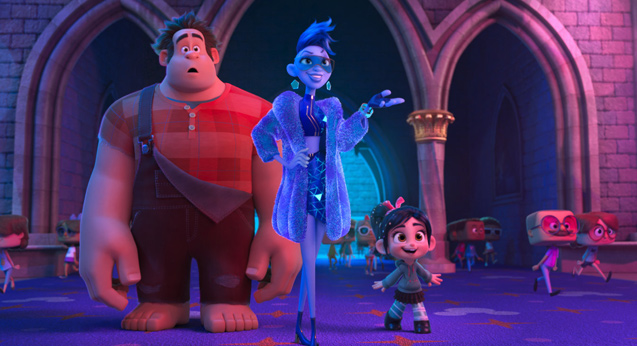Ralph Breaks the Internet has little going on… until the real story kicks in

John C. Reilly returns to voice to the sequel to Disney’s 2012 3D animated adventure, along with Sarah Silverman and an all-star voice cast. Critic Liam Maguren says you’ll need some patience to reap the film’s rewards.
Last year’s The Emoji Movie tried to manufacture popularity. It snatched something everybody’s exposed to (emojis), jammed it into a done-to-death story (“Just be yourself!”), turned the crank on the storytelling sausage-maker, deep-fried it in product placement, and plopped out a lump of crap posing as a family film. Ralph Breaks the Internet may, at first, appear to be doing the exact same thing. Give it time though, and it becomes apparent how this sequel uses online spaces to tell a valuable modern tale in a number of visually stunning ways—despite the product placement.
Ralph (John C. Reilly) and Vanellope (Sarah Silverman) have been best buds for all six years since 2012’s Wreck-It Ralph. When a damaged controller puts Vanellope’s kart-racing home Sugar Rush out of order, only the elusive ‘e-bay’ holds a spare part. Thus, the smalltown pair journey into the wide world of the web to find it.
For a solid half hour, the film’s simple-minded narrative has the characters going from A to B to C to D while passing more internet-related visual gags than anyone could possibly process in one sitting. It’s fun, for sure, but the story doesn’t seem to have much else going on for it… until Vanellope makes a sudden realisation about herself.
From here, the real story kicks in. With the introduction of Shank (Gal Gadot), an NPC from a hardout MMO racing world, and Disney’s back catalogue of princesses, together forming the single funniest scene in the entire film, Vanellope gets the opportunity to expand her identity as both a racer and a princess. Her revelation will no doubt be relatable to many adults and it’s a lesson made hilarious in the film’s only musical number.
Where does that leave Ralph? Well, hint’s in the title. He forms ties with Yesss (Taraji P Henson) who knows the fast-paced fashionability of internet trends so well, her outfit changes with every scene. As Ralph becomes a viral sensation, the film makes some surprisingly confronting statements about the fleeting adoration of online audiences, the banality of virality, and the unfiltered meanness of real-life people. They don’t complicate these themes and why should they? Younger audiences are, or soon will be, entering the world wide web with eyes as fresh as Ralph’s. Such frankness with important messages feels endearing.
Then there’s the climax. Without giving too much away, it visualises a major problem within Ralph that he’s struggled to contend with. Technically speaking, the spectacle is mighty. Artistically speaking, the moral is magnificent.
















